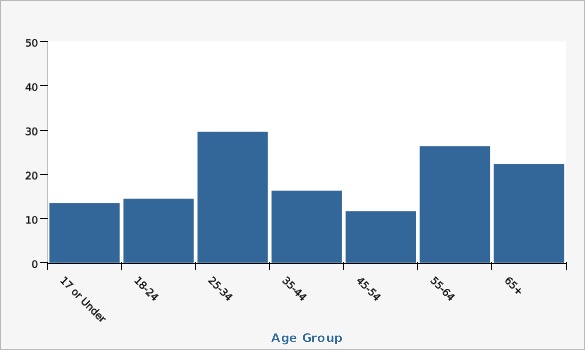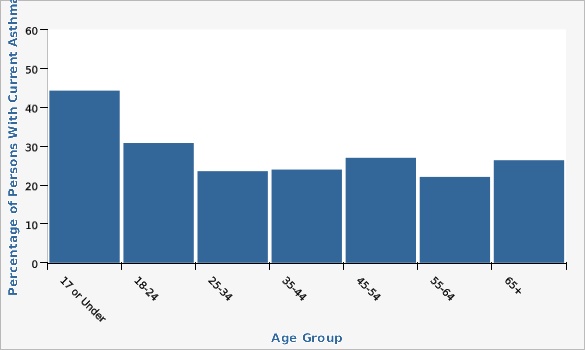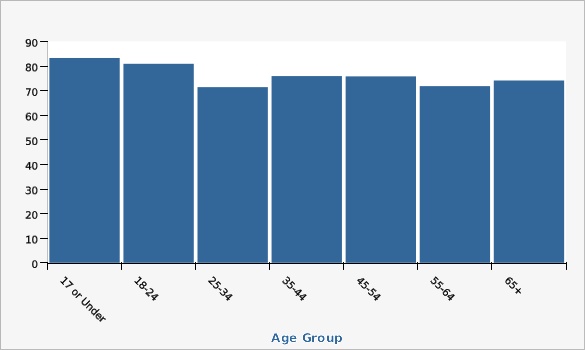Complete Health Indicator Report of Asthma Management
Definition
Individuals with current asthma who responded 'yes' to questions regarding asthma management. Current asthma includes individuals who reported having been told by a doctor that they have asthma and who currently have asthma.Numerator
Total number of individuals who responded 'yes' to asthma management questions.Denominator
Includes all survey respondents except those with missing, don't know, or refused answers to the asthma management questions.Data Interpretation Issues
In 2011, the BRFSS changed its methodology from a landline-only sample and weighting based on post-stratification to a landline/cell phone sample and raking as the weighting methodology. Raking accounts for variables such as income, education, marital status, and homeownership during weighting.Why Is This Important?
Asthma is a serious personal and public health issue that has far-reaching medical, economic, and psychosocial implications. The burden of asthma can be seen in the number of asthma-related medical events, including emergency department visits, hospitalizations, and deaths.What Is Being Done?
The Utah Asthma Program (UAP) works with the Utah Asthma Task Force and other partners to maximize the reach, impact, efficiency, and sustainability of comprehensive asthma control services in Utah. This is accomplished by providing a seamless alignment of asthma services across the public health and health care sector, ensuring that people with asthma receive all of the services they need. The UAP focuses on building program infrastructure and implementing strategies that improve asthma control, reduce asthma-related emergency department visits and hospitalizations, and reduce health care costs. Program infrastructure is strengthened through a focus on strategies to create and support a comprehensive asthma control program, these strategies include: strengthening leadership, building strategic partnerships, and using strategic communication, surveillance, and evaluation. In addition, the UAP implements strategies outlined in the Centers for Disease Control and Prevention (CDC) EXHALE technical package to improve asthma control. The six strategy areas outlined in the EXHALE technical package are: 1. Education on asthma self-management. 2. e-Xtinguishing smoking and secondhand smoke. 3. Home visits for trigger reduction and asthma self-management. 4. Achievement of guidelines-based medical management. 5. Linkages and coordination of care across settings. 6. Environmental policies or best practices to reduce asthma triggers from indoor, outdoor, and occupational sources. These strategies are expected to improve asthma control and quality of life by increasing access to health care and increasing coordination and coverage for comprehensive asthma control services both in the public health and health care sectors. Specifically, these strategies include identifying people with poorly controlled asthma, linking them to health care providers and NAEPP EPR-3 guidelines-based care, educating them on asthma self-management strategies, providing a supportive school environment, and referring to or providing home trigger reduction services for those who need them.Available Services
Individual programs in the Bureau of Health Promotion Division of Disease Control and Prevention provide information and education to citizens, physicians, and health care providers on chronic conditions. For instance, users can find helpful information on disease management and prevention at the Utah Department of Health's Asthma Program website: [http://health.utah.gov/asthma/]. A list of Utah Asthma Program services for clinicians, community health workers, and people with asthma can be found here: [http://health.utah.gov/asthma/pdfs/CAC.pdf]Health Program Information
Utah Asthma Program website: [http://www.health.utah.gov/asthma] CDC EXHALE package: [https://www.cdc.gov/asthma/pdfs/EXHALE_technical_package-508.pdf]Related Indicators
Relevant Population Characteristics
People with well controlled asthma should not experience symptoms such as wheezing or coughing, lost sleep, missed work or school days, inability to participate in physical activities, and hospitalizations due to asthma.Related Relevant Population Characteristics Indicators:
Graphical Data Views
Adults (18+) Who Were Unable to Work or Carry Out Usual Activities due to Asthma by Age Group, Utah, 2017-2018
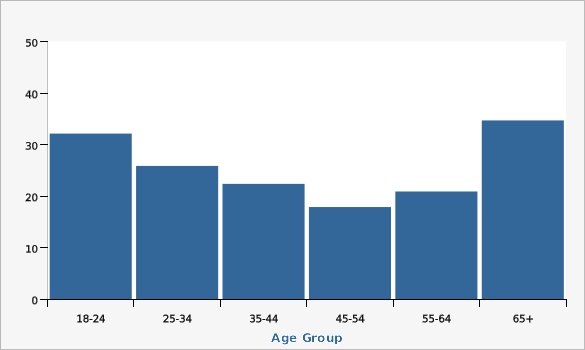
| Age Group | Lower Limit | Upper Limit | ||||
|---|---|---|---|---|---|---|
Record Count: 6 | ||||||
| 18-24 | 32.1% | 20.4% | 46.6% | |||
| 25-34 | 25.8% | 16.6% | 37.9% | |||
| 35-44 | 22.4% | 14.2% | 33.3% | |||
| 45-54 | 17.9% | 11.2% | 27.2% | |||
| 55-64 | 20.9% | 14.2% | 29.6% | |||
| 65+ | 34.7% | 27.1% | 43.2% | |||
Data Notes
Data includes those with current asthma. Adults were unable to work or carry out usual activities at least 1 day in the past 12 months due to their asthma.Data Source
Utah Behavioral Risk Factor Surveillance System Call-back SurveyAsthma Symptoms on 7+ days during the past month, Asthma Symptoms, Adults (18+) and Children (0-17), Utah, 2017-2018
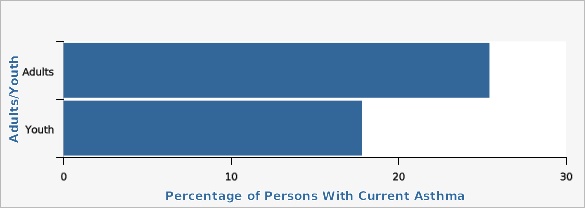
| Adults/Youth | Percentage of Persons With Current Asthma | Lower Limit | Upper Limit | |||
|---|---|---|---|---|---|---|
Record Count: 2 | ||||||
| Adults | 25.4% | 22.2% | 28.9% | |||
| Youth | 17.8% | 11.7% | 26.1% | |||
Data Notes
Data includes those with current asthma.Data Source
Utah Behavioral Risk Factor Surveillance System Call-back SurveyChildren (0-17) Who Missed at Least 1 Day of School in the Past 12 Months due to Asthma by Year, Utah, 2017-2018
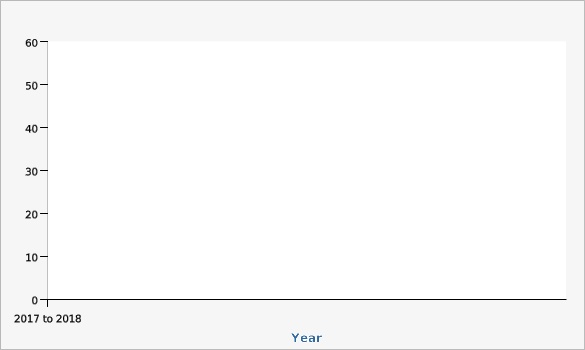
| Year | Lower Limit | Upper Limit | ||||
|---|---|---|---|---|---|---|
Record Count: 1 | ||||||
| 2017 to 2018 | 43.4% | 33.1% | 54.2% | |||
Data Notes
Data includes those with current asthma.Data Source
Utah Behavioral Risk Factor Surveillance System Call-back Survey| Age Group | Lower Limit | Upper Limit | Note | |||
|---|---|---|---|---|---|---|
Record Count: 7 | ||||||
| 17 or Under | 13.5% | 7.7% | 22.7% | |||
| 18-24 | 14.5% | 5.7% | 32.2% | * | ||
| 25-34 | 29.6% | 16.6% | 47.1% | |||
| 35-44 | 16.3% | 7.9% | 30.7% | * | ||
| 45-54 | 11.7% | 4.6% | 26.7% | * | ||
| 55-64 | 26.4% | 16.3% | 39.6% | |||
| 65+ | 22.3% | 14.7% | 32.4% | |||
Data Notes
Data includes those with current asthma. Percentage of respondents who reported limiting their activity due to asthma in the past 30 days "A moderate amount" or "a lot". *Use caution in interpreting. The estimate has a coefficient of variation >30% and is therefore deemed unreliable by Utah Department of Health standards.Data Source
Utah Behavioral Risk Factor Surveillance System Call-back Survey| Age Group | Lower Limit | Upper Limit | ||||
|---|---|---|---|---|---|---|
Record Count: 7 | ||||||
| 17 or Under | 62.5% | 51.4% | 72.4% | |||
| 18-24 | 69.0% | 53.3% | 81.3% | |||
| 25-34 | 58.0% | 45.3% | 69.7% | |||
| 35-44 | 43.6% | 32.4% | 55.6% | |||
| 45-54 | 61.2% | 49.5% | 71.7% | |||
| 55-64 | 52.6% | 41.9% | 63.0% | |||
| 65+ | 57.9% | 49.0% | 66.4% | |||
Data Notes
Data includes those with current asthma.Data Source
Utah Behavioral Risk Factor Surveillance System Call-back Survey| Age Group | Percentage of Persons With Current Asthma | Lower Limit | Upper Limit | |||
|---|---|---|---|---|---|---|
Record Count: 7 | ||||||
| 17 or Under | 44.3% | 35.5% | 53.5% | |||
| 18-24 | 30.8% | 19.5% | 45.0% | |||
| 25-34 | 23.6% | 16.1% | 33.1% | |||
| 35-44 | 24.0% | 16.6% | 33.4% | |||
| 45-54 | 27.0% | 19.2% | 36.6% | |||
| 55-64 | 22.1% | 15.8% | 30.1% | |||
| 65+ | 26.4% | 20.2% | 33.6% | |||
Data Notes
Percentages include those who responded "yes" to the question "Has a doctor or other health professional EVER given you an asthma action plan?"Data Source
Utah Behavioral Risk Factor Surveillance System Call-back Survey| Age Group | Lower Limit | Upper Limit | ||||
|---|---|---|---|---|---|---|
Record Count: 7 | ||||||
| 17 or Under | 83.3% | 75.1% | 89.2% | |||
| 18-24 | 80.9% | 69.7% | 88.7% | |||
| 25-34 | 71.4% | 62.0% | 79.3% | |||
| 35-44 | 75.9% | 67.0% | 83.0% | |||
| 45-54 | 75.8% | 65.5% | 83.8% | |||
| 55-64 | 71.9% | 62.6% | 79.6% | |||
| 65+ | 74.1% | 66.7% | 80.4% | |||
Data Notes
Data includes those with current asthma.Data Source
Utah Behavioral Risk Factor Surveillance System Call-back SurveyMore Resources and Links
Evidence-based community health improvement ideas and interventions may be found at the following sites:- Centers for Disease Control and Prevention (CDC) WONDER Database, a system for disseminating public health data and information.
- United States Census Bureau data dashboard.
- Utah healthy Places Index, evidence-based and peer-reviewed tool, supports efforts to prioritize equitable community investments, develop critical programs and policies across the state, and much more.
- County Health Rankings
- Kaiser Family Foundation's StateHealthFacts.org
- Medical literature can be queried at PubMed library.
Page Content Updated On 03/01/2022,
Published on 03/01/2022

